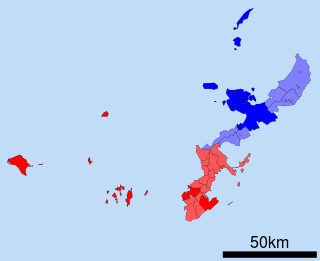Kunigami language
| Kunigami | |
|---|---|
| 山原言葉/ヤンバルクトゥーバ Yanbaru Kutuuba | |
| Native to | Japan |
| Region | Northern Okinawa Island |
Native speakers | 5,000 (2004)[1] |
| Language codes | |
| ISO 639-3 | Variously:xug – Kunigamiokn – Oki-No-Erabuyox – Yoron |
 Kunigami (Kunigami) | |
The Kunigami language (山原言葉/ヤンバルクトゥーバ, Yanbaru Kutuuba) is a Ryukyuan language spoken on Okinawa Island in the northern Kunigami or Yanbaru region, historically the territory of the Hokuzan kingdom. According to UNESCO, the Kunigami language includes the Okinoerabujima dialect (島ムニ Shimamuni) and the Yoronjima dialect (ユンヌフトゥバ Yunnu futuba) in the Amami Islands of Kagoshima Prefecture.[2] Other classifications, including those used by Ethnologue and in the International Encyclopedia of Linguistics, view Okinoerabu and Yoron as languages distinct from Kunigami.[3][4]
Like the Okinawan language, Kunigami is one of the Okinawan languages. The Nakijin dialect is often referred to as representative of Kunigami, in comparison with the Shuri/Naha dialect in the central Okinawan. The number of fluent native speakers of Kunigami is not known. As a result of Japanese language policy, the younger generation mostly speaks Japanese as their first language.
In Japan, the Ryukyuan language family does not have national recognition as a language but are considered dialects despite the lack of mutual intelligibility with Japanese. As a result, the Kunigami language is referred to as the Okinoerabu–Yoron–Northern Okinawa dialects (沖永良部与論沖縄北部諸方言, Okinoerabu Yoron Okinawa Hokubu Shohōgen).
Folk terminology
The speakers of Kunigami have various words for "language", "dialect", and "style of speech". For example, linguist Nakasone Seizen (1907–1995) stated that the dialect of his home community Yonamine, Nakijin Village had (corresponding Standard Japanese word forms in parentheses): /ku⸢cii/ (kuchi), /hutˀuu⸢ba/ (kotoba) and /munu⸢ʔii/ (monoii). The language of one's own community was referred to as /simaagu⸢cii/ or /sima(a)ku⸢tˀuu⸣ba/.[5] The Yonamine dialect was part of Nakijin's western dialect called /ʔiriɴsimaa kutˀuba/.[6] The northern part of Okinawa was colloquially known as Yanbaru and hence its language was sometimes called /'jaɴ⸢ba⸣rukutˀuuba/.[7]
Status
Kunigami has no official status. Ethnologue identifies its status as 7 (Shifting).[8] The younger generation mostly speaks Japanese as their first language.
Phonology
The Kunigami language presents some unique phonological characteristics that set it apart from other Japonic languages. One of the most notable characteristics of Kunigami phonology is the existence of a full series of "tensed" or "glottalized" consonants, including stops, nasals, and glides. Kunigami is also notable for the presence of an /h/ phoneme separate from /p/, which is believed to be the historical source of /h/ in modern dialects of the Japanese language. Thus, for example, the Nakijin dialect of Kunigami has /haʔkáí/ (“a light, a lamp, lamplight; a shōji, a translucent paper screen, a translucent paper sliding door”; accented vowels indicate morae pronounced with a high tone), which is cognate with Japanese /akárí/ (“light, bright light, a ray of light, a beam of light; a light, a lamp, lamplight”); the Kunigami form is distinguished from its Japanese cognate by the initial /h/, glottalized /ʔk/, and elision of Proto-Japonic *r before *i. The Kunigami language also makes distinctions in certain word pairs, such as Nakijin dialect /ʔkumuú/ (cloud) and /húbu/ (spider), which both appear as /kúmo/ in Japanese.
Morphology
One notable difference in the use of certain morphological markers between Kunigami language and Standard Japanese is the use of the /-sa/ form as an adverb in Kunigami: e.g. Nakijin dialect /tuusá panaaɽíʔtun/, which is equivalent to Standard Japanese toókú hanárete irú ("It is far away"). In Standard Japanese, the /-ku/ form is used adverbially, while the /-sa/ form is used exclusively to derive abstract nouns of quality ("-ness" forms) from adjectival stems.
References
- ^ Kunigami at Ethnologue (17th ed., 2013)

Oki-No-Erabu at Ethnologue (17th ed., 2013)
Yoron at Ethnologue (17th ed., 2013)
- ^ "UNESCO Atlas of the World's Languages in danger". Retrieved 20 October 2014.
- ^ International Encyclopedia of Linguistics: AAVE - Esperanto. Oxford University Press. 2003. p. 335. ISBN 978-0-19-513977-8.
- ^ Tomoko Arakaki (28 June 2013). Evidentials in Ryukyuan: the Shuri Variety of Luchuan: A Typological and Theoretical Study of Grammatical Evidentiality. BRILL. p. 7. ISBN 978-90-04-25340-7.
- ^ "Nakijin Dialect Dictionary: kotoba" (in Japanese). Retrieved 1 February 2014.
- ^ "Nakijin Dialect Dictionary: Nakijin-hōgen gaisetsu" (in Japanese). Retrieved 1 February 2014.
- ^ "Nakijin Dialect Dictionary: yanbaru kotoba" (in Japanese). Retrieved 1 February 2014.
- ^ "Amami-Okinawan". SIL International. Retrieved 1 February 2014.
